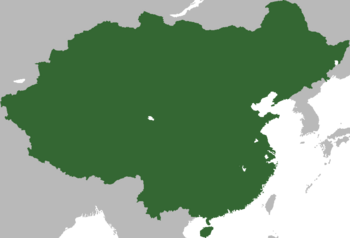China (TNO:ANM)
Republic of China
| |
|---|---|
| Anthem: 中华民国国歌 Jūnghuá Mínguó Guógē "National Anthem of the Republic of China" | |
 Location map of China in Asia | |
| Capital | Nanjing 32°03′39″N 118°46′44″E |
| Largest | Shanghai |
| Official languages | Standard Chinese |
| Recognised regional languages | Mongolian (Mongolia) |
| Demonym(s) | Chinese |
| Government | Unitary dominant-party parliamentary republic |
| Ju Liluen | |
| Jiang Chichen | |
| Han Guoyu | |
| Shiu Tzunglì | |
| Legislature | Bicameralism |
| National Assembly | |
| Legislative Yuan | |
| Formation | |
| c. 2070 BCE | |
| 221 BCE | |
| 1 January 1912 | |
• Independence from Japan | 1 October 1978 |
• Admitted to the Coalition of Nations | 7 July 1981 |
• Latest constitution | 20 December 1989 |
| Area | |
• Total | 10,125,113 km2 (3,909,328 sq mi) (2nd) |
| Population | |
• 2023 estimate | 1.508 billion (1st) |
• Density | 148.93/km2 (385.7/sq mi) |
| GDP (nominal) | 2023 estimate |
• Total | $22.82 trillion (2nd) |
• Per capita | $15,132 |
| Gini (2021) | 37.4 medium |
| HDI | very high |
| Currency | Chinese Dollar (CN$) (CND) |
| Time zone | UTC+5:30 to 8 |
| Date format | yyyy-mm-dd or yyyy年m月d日 (CE; Chinese calendar) |
| Driving side | right |
| Calling code | +86 |
| ISO 3166 code | CN |
| Internet TLD | .cn |
China,[a] officially the Republic of China,[b] is a country in East Asia. It is the world's largest country by population with a population of over 1.5 billion spread across 10.125 million square kilometres, the second largest area of any country on Earth. China spans over five time zones and borders Russia to the north, west and east, Afghanistan to the west, India, Nepal and Burma to the southwest, Thailand, Laos and Vietnam to the south, and the pacific ocean to the east. Its capital is Nanjing, while its largest city, Shanghai, is the third largest city in the world by population.
Chinese civilization, regarded as one of the cradles of civilization, began in the Yellow River Valley. The Shang dynasty, the first Chinese dynasty for which there is historical evidence of, emerged in the 2nd millennium BCE. Its successor state, the Zhou, expanded its territory across modern day northern and southern China. Chin Shi Huang established the first imperial dynasty of China, the short-lived Qin dynasty in 221 BCE, laying the groundwork for the system of government that would define China until the 20th century. China's imperial dynastic history along stretched over 2 millennia, with notable dynasties including the Han, Tang, Song, Ming and Qing dynasties. The Shinhai revolution brought an end to the monarchical system in China, at the cost of a period of political instability for the new republic. In 1927, the government of the republic was taken over by the Kuomintang, led by Chiang Kai-Shek. China was later invaded by Japan, first taking over Manchuria and then coming to conquer most of China throughout the late 1930s to 40s. China economically, politically and technologically stagnated as a result of its exploitation by Japan; subsequent rapid modernizations and reforms to the military, economy and infrastructure brought China to the ranks of a world-class economy. China's victory over Japan in the Great Asian War ended the Japanese colonial empire in Asia, with China having now taken Japan's place as a superpower.
In addition to being one of the world's largest countries both by area and population, China is home to the second largest economy in the world by GDP nominal and the largest economy in the world by GDP (PPP). China is a member of the Coalition of Nations, the GEATO, the World Trade Organization among other international groups. China is the world's largest democracy by population and boasts among the largest militaries in the world by active personnel.

